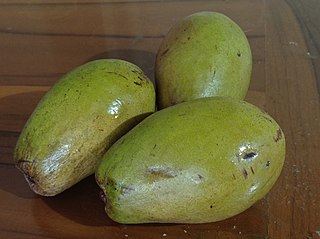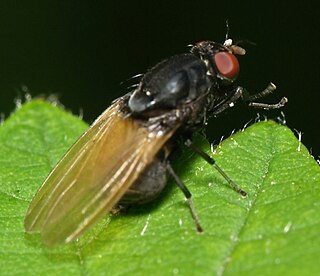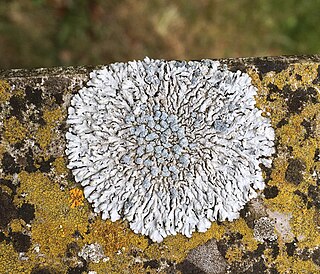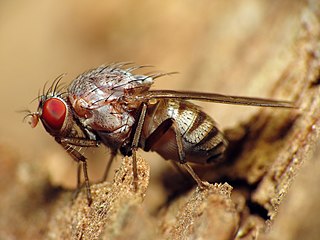
Cretzschmar's bunting is a passerine bird in the bunting family Emberizidae, a group now separated by most modern authors from the finches, Fringillidae.

Eucalyptus caesia, commonly known as caesia or gungurru, is a species of mallee that is endemic to the south-west of Western Australia. It has smooth reddish brown bark at first, later shedding in curling flakes, lance-shaped, sometimes curved adult leaves, club-shaped flower buds covered with a waxy, bluish white bloom, pink stamens with yellow anthers and urn-shaped fruit.

Mangifera caesia is a species of flowering plant in the cashew family, Anacardiaceae. Known in English as jack or white mango, among other names. It belongs to the same genus as the mango and is widely cultivated in areas of Indonesia, Malaysia, Singapore, Brunei, Papua New Guinea and the Philippines.

The Lauxaniidae are a family of acalyptrate flies. They generally are small flies with large compound eyes that often are brightly coloured in life, sometimes with characteristic horizontal stripes, such as in Cestrotus species. Many species have variegated patterns on their wings, but in contrast they generally do not have variegated bodies, except for genera such as Cestrotus, whose camouflage mimics lichens or the texture of granitic rocks.

Caesia is a genus of herbs in the family Asphodelaceae, subfamily Hemerocallidoideae, native to Australia, New Guinea, Madagascar and Southern Africa. The mostly 3-lobed seed capsules contain rounded black seeds. The genus was named in honour of Federico Cesi (1585-1630), an Italian scientist.

Curcuma caesia, black turmeric or black zedoary, is a perennial herb with bluish-black rhizomes that is native to northeast India.

Solidago caesia, commonly named blue-stemmed goldenrod, wreath goldenrod, or woodland goldenrod, is a flowering plant native to North America.

Catocala caesia is a moth of the family Erebidae. It is found in the mountains of south-eastern Arizona and south-western New Mexico, and southward through the Sierra Madre Occidental in Chihuahua (Mexico).
Rippon Glacier is a small glacier located in Kemp Land, East Antarctica. It is close east of Seaton Glacier, flowing southward into Edward VIII Ice Shelf.

Minettia is a genus of small flies of the family Lauxaniidae. They have almost worldwide distribution, is one of the most species rich genera of the family with more than 120 described species. The Palaearctic is the most diverse with some 56 described species. The genus is divided into 3 subgenera.

Leptophobia caesia, the bluish white, is a butterfly in the family Pieridae. The species was first described by Hippolyte Lucas in 1852. It is found from Mexico to Ecuador. This butterfly inhabits various environments, including tropical and subtropical forests, and is often seen near rivers and streams. Leptophobia caesia is known for its delicate, pale blue to white wings, which provide effective camouflage against predators. Its presence contributes to the biodiversity of the regions it inhabits, and it plays a role in pollination, thus supporting the local ecosystems.

Physcia caesia, known colloquially as blue-gray rosette lichen and powder-back lichen, is a species of foliose lichenized fungus. First described by Georg Franz Hoffmann in 1784, it is common across much of Europe, North America and New Zealand, and more patchily distributed in South America, Asia, Australia and Antarctica. There are 2 subspecies: P. c. caesia and P. c. ventosa, as well as a number of distinct forms and varieties. Molecular studies suggest that the species as currently defined may be polyphyletic. It is typically pale gray shading to darker gray in the center, and grows in a small rosette, usually some 2–3 cm (0.79–1.18 in) across at maturity. It only rarely has apothecia, instead reproducing most often vegetatively via soredia, which are piled in round blue-gray mounds across the thallus's upper surface. It grows most often on rock—principally calcareous, but also basaltic and siliceous—and also occurs on bone, bark and soil. It is nitrophilic and is particularly common on substrates where birds perch.
Minettia lupulina is a species of fly in the family Lauxaniidae.

Minettia fasciata is a species of fly in the family Lauxaniidae.
Antiplecta is a genus of scoopwing moths in the family Uraniidae. There are about five described species in Antiplecta.
Minettia shewelli is a species of fly in the family of Lauxaniidae.
Minettia flaveola is a species of fly in the family Lauxaniidae.
Minettia lobata is a species of fly in the family Lauxaniidae.

Minettia magna is a species of fly in the family Lauxaniidae.
Caesia is a genus of sea snails in the subfamily Nassariinae of the family Nassariidae.












